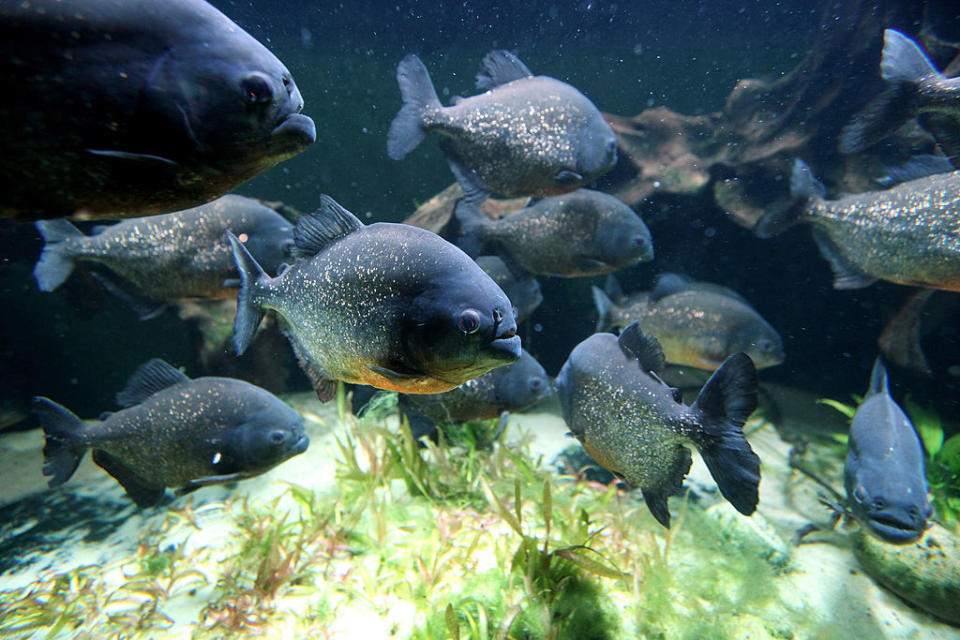How fast can piranhas eat a dog?

When we think of piranhas, we often conjure up an image of fearsome predators that can strip an animal to its skeleton in seconds. Their bad reputation stems, in part, from President Theodore Roosevelt, who, after a trip to the Amazon, wrote that they were the "most ferocious fish in the world."
"They will snap a finger off a hand incautiously trailed in the water; they mutilate swimmers — in every river town in Paraguay there are men who have been thus mutilated; they will rend and devour alive any wounded man or beast; for blood in the water excites them to madness," he wrote in his book "Through the Brazilian Wilderness."
But while these freshwater fish have razor-sharp teeth, are they really as dangerous as we think? And how fast can they really consume their prey?
Many species of piranha are omnivores, said Kristine Grzenda, curator of behavior and welfare at Audubon Aquarium in New Orleans. For example, red-bellied piranhas (Pygocentrus nattereri) — which are often associated with attacks on humans — tend to feed on fish, crustaceans, insects, plants, fruits, nuts and seeds, but some individuals in this species have also been found with pieces of birds, snakes and small mammals in their stomachs.
Related: Piranhas swarm 8 tourists at Brazilian resort, leaving them with bloody legs and feet
"It's the carnivorous piranhas that have a reputation for eating the flesh of small and large mammals," she told Live Science. Red-bellied piranhas (Pygocentrus nattereri) are omnivorous, while other species such as tambaqui (Colossoma macropomum), a close relative of the piranha, are herbivores. "While they are very food motivated fish that are able to eat large quantities of food, their staple diet items are smaller food items."

Piranhas can be found in groups of anything from below 10 to 100 fish, Grzenda said, but this is for protection rather than hunting. "They have their place in the food chain as both predator and prey," she said. "Like other animals, though, piranhas may become more aggressive if their food supply is low." Piranhas have natural predators, including the black caiman (Melanosuchus niger).
Allison Waltz-Hill, senior aquarist at the New England Aquarium's Temperate Gallery, told Live Science that a single piranha can move and consume prey quickly.
"Let's say that the average adult red-bellied piranha weighs 541 grams [19 ounces]," she said. "We regularly feed our piranhas about 12 grams [0.4 oz] each in one feed, which maybe lasts for 30 seconds. But, let's be generous and say that these piranha are really hungry and could eat 1/8th of their body weight in a feed (which is behavior that has been observed in the aquarium) — which would be 68 grams [2.4 oz] per fish.
RELATED STORIES
—Ocean pout: The fish with antifreeze blood
—Shark has virgin birth after no male contact for 4 years in Chicago zoo
"So, if we had a 50-pound [22.7 kilograms] dog — and subtracted 10 pounds [4.5 kg] to account for bone and fur — it would take around 267 adult piranha about 3 minutes to eat it," Waltz-Hill said. However, this depends on many variables, including how hungry the piranhas are and their size, she added.
Piranhas are opportunistic feeders, and the chance to eat a dog doesn't come along very often. They're more likely to go for easier, more accessible food like small fish or fruit. Grzenda noted that their sharp teeth are also handy for eating harder foods like shellfish.
"Despite their appearance, piranhas' reputation is largely unearned and accounts of their feeding habits are often exaggerated," Waltz-Hill said. "Piranhas are only likely to attack a much larger animal if it is seriously injured or already dead. When not scavenging, piranhas mostly prey on other fishes by taking bites out of larger fishes or fully consuming smaller fishes."

